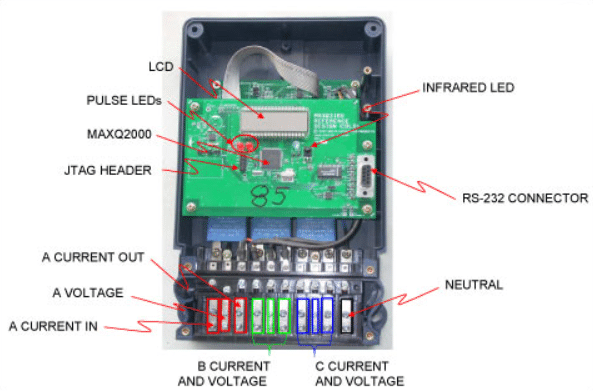Reference design for a polyphase energy meter with a meter accuracy of class 0.5s for active power and class 2 for reactive power measurements.
The meter can calculate various energy parameters including active/reactive/apparent power, power factors, and harmonic components.

The MAXQ3183 3-phase energy meter reference design from Analog Devices offers a comprehensive set of features and specifications for accurate energy measurement and power monitoring. The reference design is based on the MAXQ3183 polyphase multifunction analog front end (AFE) and MAXQ2000 microcontroller, this design provides a reliable solution for various metering applications. The reference design supports 3-phase four-wire systems and operates at AC conditions of 50Hz/60Hz, 220V, 9A². It offers a meter constant of 6400 and achieves a meter accuracy of class 0.5s for active power and class 2 for reactive power measurements. The MAXQ3183 reference design features serial communication with a PC which is supported at baud rates of 1200/9600/57600/115200.
The MAXQ3183 AFE integrates an 8-channel high-accuracy ADC and a digital signal processor (DSP). The DSP processes ADC samples, enabling the calculation of energy and power-measurement parameters such as active/reactive/apparent power, power factors, and harmonic components. The AFE’s SPI port facilitates seamless communication with a host controller. The reference design includes PC software for convenient evaluation and calibration of the meter. The software supports parameter display and retrieval, including voltage RMS, current RMS, power factors, harmonics, and more. It also provides calibration screens for gain, phase angle, and linearity adjustments. The intuitive graphical interface enhances the understanding and analysis of metering functions.
The reference design comprises a measurement board (hot board) and a main board (cold board). The hot board handles AC-input circuits and hosts the MAXQ3183, while the cold board houses the microcontroller and display. The MAXQ3183 reference design offers several advantages, including support for positive/negative energy and power measurements, RMS voltage and current calculations, and neutral current monitoring. It also provides features like temperature sensing, phase sequence indication, harmonics measurement, and pulse output for added functionality. The SPI slave interface simplifies communication, while the compact TSSOP package enhances space efficiency.
ADI also offers two other models of polyphase electric meter which are almost similar to the MAXQ3183. The MAXQ3180 and MAXQ3183 models provide more advanced capabilities and a wider range of measurement parameters compared to the MAXQ3181, making them suitable for more sophisticated energy metering applications. MAXQ3181 is fully pin compatible with the MAXQ3180, and its registers are a subset of the MAXQ3180’s registers.
The three models in the MAXQ3180/MAXQ3183 polyphase AFE family have some key differences in their features and capabilities that are mentioned below:
Features of MAXQ3181:
- Supports active energy and power measurements only.
- Does not include features for reactive energy and power measurements.
- Provides voltage and current RMS calculations.
- Does not support neutral current monitoring.
- Offers a simplified feature set compared to the other models.
Features of MAXQ3180:
- Supports both active and reactive energy and power measurements.
- Includes voltage and current RMS calculations.
- Supports neutral current monitoring.
- Provides additional features such as voltage and current harmonics measurement.
- Offers a comprehensive feature set for accurate energy measurement.
Features of MAXQ3183:
- Supports both active and reactive energy and power measurements.
- Includes voltage and current RMS calculations.
- Supports neutral current monitoring.
- Provides additional features such as vector sum of currents.
- Includes temperature sensing and phase sequence indication.
- Offers the most comprehensive feature set among the three models.
This reference design has been tested by Analog Devices. It comes with required design resources such as sample code, schematics, BoM, etc. You can find additional data about the reference design on the company’s website. To read more about this reference design click here.








